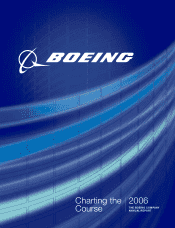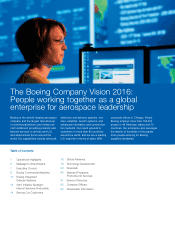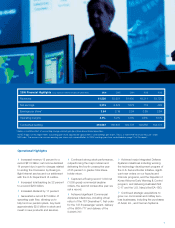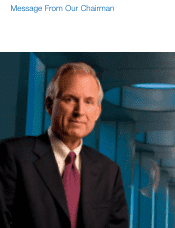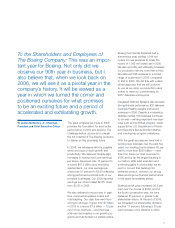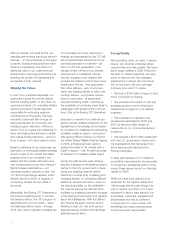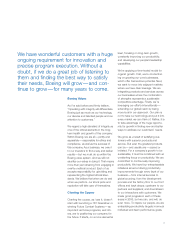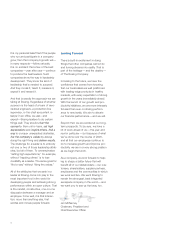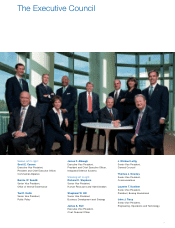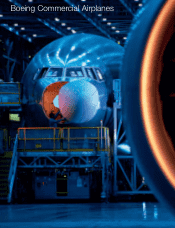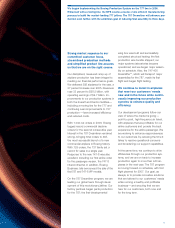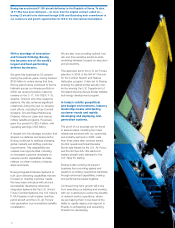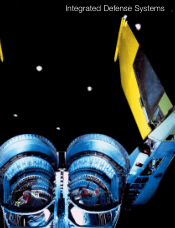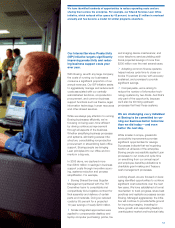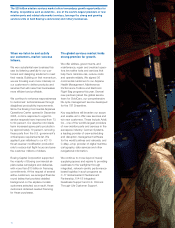Boeing 2006 Annual Report Download - page 6
Download and view the complete annual report
Please find page 6 of the 2006 Boeing annual report below. You can navigate through the pages in the report by either clicking on the pages listed below, or by using the keyword search tool below to find specific information within the annual report.
4
With our thanks, full credit for this out-
standing performance should go where it
belongs — to the employees of this great
company. Boeing employees have main-
tained an unwavering commitment to
delivering value to our customers and
shareholders, improving productivity and
enabling the growth of businesses that
are leaders in their markets.
Shaping the Future
In one of our principal businesses, our
customers include the world’s airlines
and the traveling public. In the other, our
customers include U.S. and allied military
services and governmental agencies
responsible for protecting people in
countries around the globe. We have
wonderful customers with a huge on-
going requirement for innovation and
precise program execution. Without a
doubt, if we do a great job of listening to
them and finding the best way to satisfy
their needs, Boeing will grow — and con-
tinue to grow — for many years to come.
Based on listening to our customers, we
have built our commercial airplane strategy
around a view of the market that distin-
guishes us from our competitor. We
believe that the market demands more
new nonstop service and more frequent
flights between destinations — not
increased airplane capacity or size. The
777-200 Longer Range airplane, which
entered service in 2006, is capable of
connecting virtually any two cities in
the world.
Meanwhile, the Boeing 787 Dreamliner is
the most successful launch in commer-
cial airplane history. The 787 program is
essentially sold out from 2008 — when
first deliveries will be made — through
2012. As a result of greatly increased use
of composites and other advances in
engines and aerodynamics, the 787 will
use 20 percent less fuel and be 30 per-
cent less expensive to maintain — all
that, to put it into perspective, in an
industry where a three or four percent
improvement is considered a break-
through. Imagine a new airplane that
provides the highest comfort level of any
widebody in the sky…that goes faster
than other jetliners…and, most impor-
tantly, that enables airlines to offer more
nonstop service…and greater conven-
ience to customers…at significantly
reduced operating costs…opening up
the possibility of combining lower fares to
passengers with greater profit to the air-
lines. That is the Boeing 787 Dreamliner.
Execution in several of our defense pro-
grams involves systems integration at the
highest level of knowledge and complex-
ity. Consider the challenge of intercepting
a ballistic missile in space — and poten-
tially saving millions of lives. In a test for
the United States’ Missile Defense Agency
in 2006, a Boeing-led team demon-
strated the ability to “hit a bullet with a
bullet” in space — with the sixth success-
ful intercept of a ballistic missile target.
During the past several years, Boeing
has also emerged as the leading industry
partner to the U.S. government in devel-
oping and applying network-centric
solutions to a wide array of existing and
emerging threats. In connecting different
platforms, sensors and units — down to
the individual soldier on the battlefield —
the network acts as the ultimate force
multiplier by enabling a dramatic increase
in the sharing of information and capabili-
ties in the battlespace. With the SBInet
win, Boeing will apply network-centric
thinking to help U.S. law enforcement
agencies secure borders and halt illegal
activities around them.
Facing Reality
Not everything came up roses. It seldom
does in any dynamic enterprise where
opportunities and risks coexist. We faced
some tough realities in 2006. Where we
fell short or missed objectives, we were
quick to respond with the necessary
adjustments to reduce risk and reposi-
tion for the future. We are a stronger
company as a result. To review:
RWe took a $320 million charge to shut
down Connexion by Boeing.
RWe absorbed the impact of cost and
schedule growth on some fixed-price
development programs in our defense
business.
RWe increased our research-and-
development spending for 2006 and
2007 by almost a billion dollars to
reduce risk on our commercial airplane
programs.
RWe reached a $615 million settlement
with the U.S. government, thereby end-
ing investigations that had arisen from
some serious past misconduct by
Boeing employees.
In large part because of our collective
productivity improvements, we were able
to overcome a substantial portion of the
impact these issues had on our financial
results for 2006.
While we could have claimed a tax
deduction for the litigation settlement,
I felt strongly that the right thing to do
was to deduct no portion of it. It was
important to send a clear signal to our
employees, customers, suppliers and
shareholders that this is a different
company set on a new course, and
benefiting from these circumstances
would have been inappropriate.

